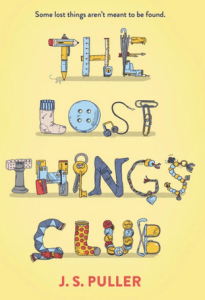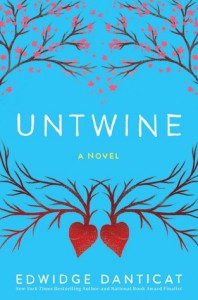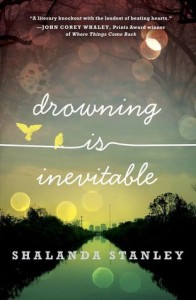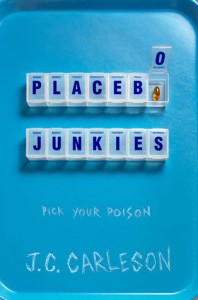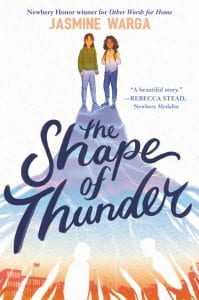 Warga, Jasmine. The Shape of Thunder. Balzar & Bray, 2021. 978-0-062-95667-5. $16.99. 275 p. Grades 5-8.
Warga, Jasmine. The Shape of Thunder. Balzar & Bray, 2021. 978-0-062-95667-5. $16.99. 275 p. Grades 5-8.
Cora Hamid and Quinn Macauley are next door neighbors and inseparable friends all their twelve years of life–until they are not. Quinn’s older brother, Parker, takes his father’s hunting guns to his high school one November morning and shoots Cora’s sister, Mabel, a teacher, another student, and himself. The two families’ approach to grief could not be more different. Abandoned as a baby by her mother (the reader never discovers why), Lebanese-American and Muslim Cora has the nurturing support of her biologist dad; thoughtful, maternal Gram; and the professional support of a trained therapist. Quinn’s family buries the issue. Told in alternating voices, the reticent and less academic Quinn has difficulty expressing her thoughts and guilty feelings. Her workaholic father is against any outside help to ease the family’s suffering, and her mother hides in the house cooking and baking. Longing to reconnect with Cora, Quinn delivers a box to her doorstep stuffed with articles about time travel and wormholes on Cora’s birthday. She knows Cora well enough to appeal to her scientific nature. Perhaps the two of them could find a wormhole and travel back in time to stop the tragedy of that fateful day. As the pair work through the logistics of approaching a huge tree in the forest for the site of their wormhole/time traveling, they each experience the pain of regret and the insistence on holding fast to the memory of a loved one. While Cora has made new friends on her Junior Quizbowl Team and excels in her studies, Quinn has felt shunned. She longs to be on the soccer team, but is too ashamed to try out. Her art gives her some pleasure, yet not even drawing can remove the heavy weight of a secret she knows about her brother, the possibility that she could have prevented the circumstances. After she confides in the school librarian her remorse, she resolves to confess this awful secret to Cora. Though the revelation breaks their renewed bond, Cora devotes more time to her plan to make the impossible possible. When she questions her father about time travel, she is encouraged and inspired by his answer. He tells her that her absent mother had a theory comparing the shape of time to the shape of thunder: “impossible to map” (p. 213). When both Cora and Quinn are coaxed by different people to attend the traditional Fall Festival at their middle school, the rumble of thunder pulls the two estranged girls to the woods to prove Cora’s theory. The hopeful resolution of the story, despite the sadness surrounding it, gives the reader relief. Quinn’s and Cora’s relationship see-saws throughout realistically. After all, Quinn reminds Cora of the unspeakable thing Parker did. Quinn’s strained home life with her parents who refuse any kind of self-reflection or examination of the devastating action of their son is painful. Minor situations like the jealousy of Mia, another friend of Cora’s, toward Quinn; the snide remarks of Quinn’s former teammate and friend; the growing crush Cora has with her classmate, Owen (a Japanese-American character), will resonate genuinely with middle school readers. The Shape of Thunder is a tough read, but one that confirms that happiness can co-exist with grief, and friendships can be mended.
THOUGHTS: This novel is full of emotion and rich in language and characterization, but not so intense that a sensitive middle grade student would be put off. Cora is a thinker and an intellectual. Throughout the novel, students will find themselves entertained by the interesting facts Cora spouts (“…cows kill more people than sharks each year…”). The images Warga uses to describe different feelings are unique but spot on (the “fizziness” Cora feels in her tummy when talking to her crush, Owen, etc.). She also makes dialogue very interesting. Quinn has a hard time speaking; her brain freezes and she can’t say the words. When she finally gets angry enough to spill over her feelings to her buttoned up family, it is heartbreaking. The conversations between Cora and her father and grandmother also are authentic and tell the reader so much about the characters. What the reader must conjecture about are Parker’s reason for the shooting and the absence of Cora’s mother since her father seems to have no obvious vices. Ms. Euclid, the school librarian and art teacher, is a heroine for Quinn. This book should be issued with a box of tissues.
Realistic Fiction Bernadette Cooke, School District of Philadelphia

